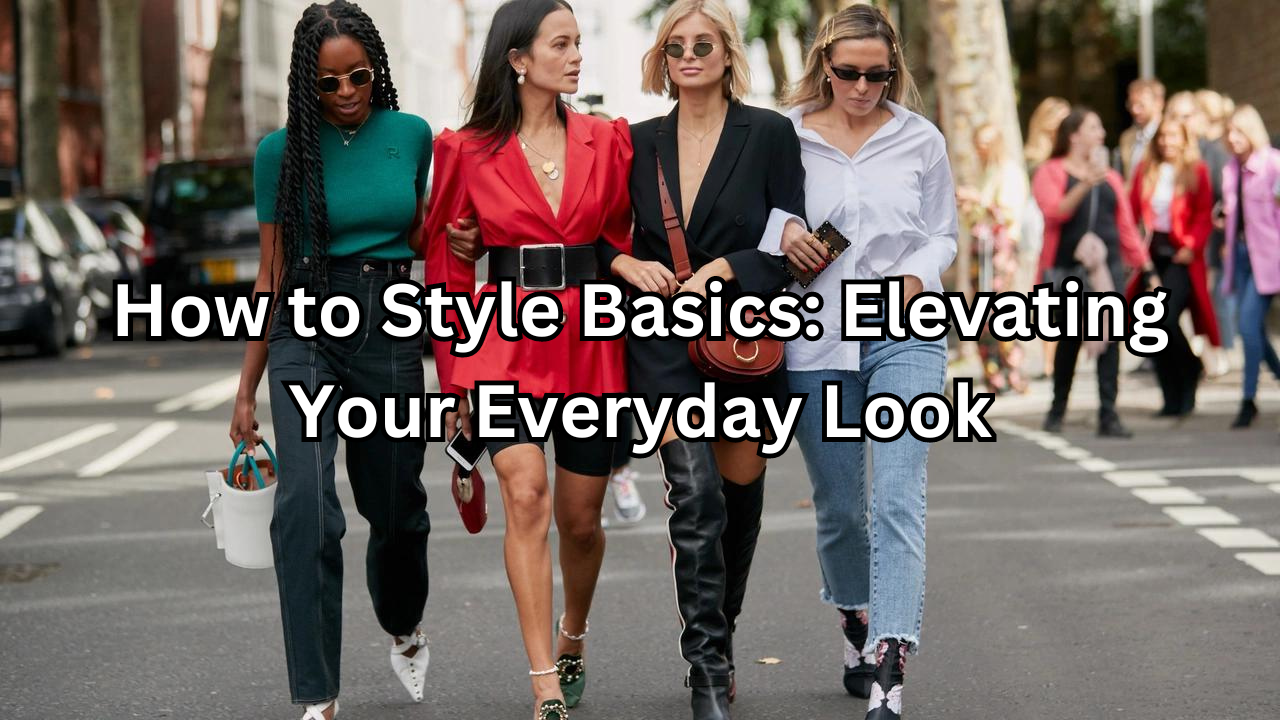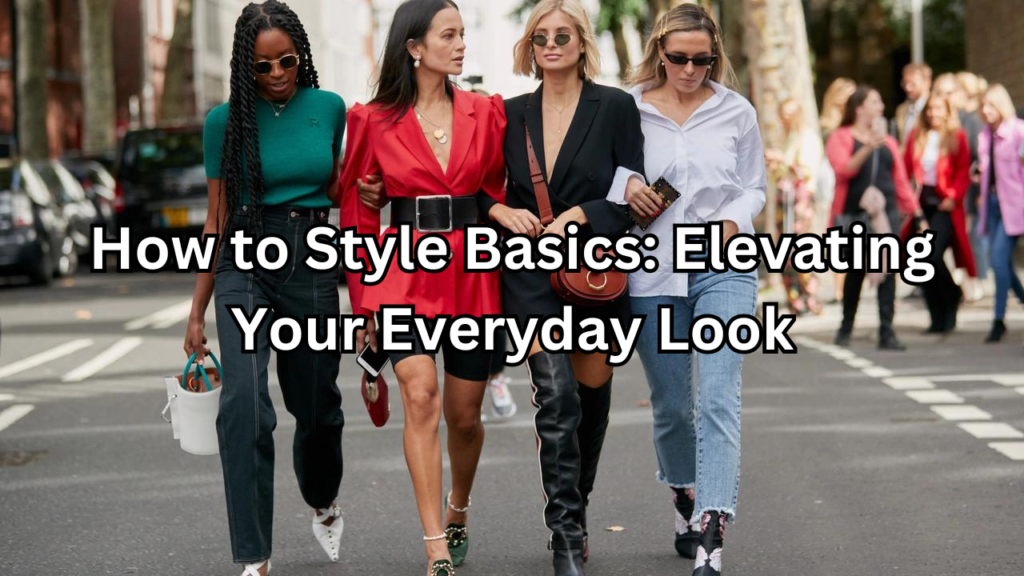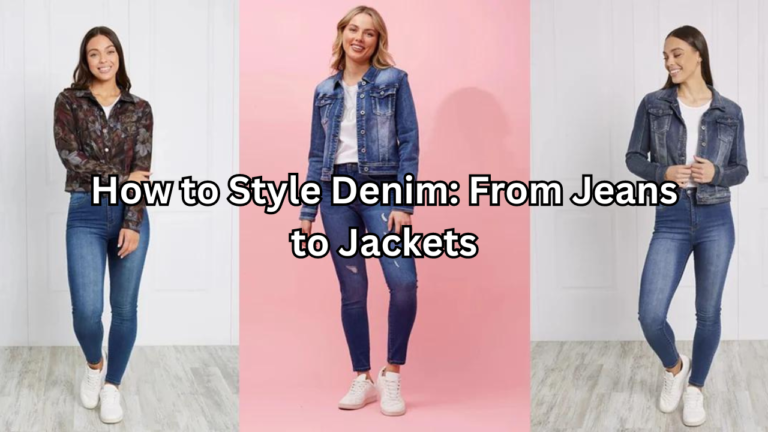

Table of Contents
Introduction
Elevating Your Everyday Look, the term “basics” might sound mundane, but it’s anything but ordinary. Basics are the fundamental pieces that form the backbone of any wardrobe—think classic white tees, versatile jeans, and simple sweaters. These items may seem simple, but their true potential lies in how you style them. Mastering the art of elevating your everyday look, making it not only stylish but also uniquely yours. Whether you’re aiming for a polished office look or a casual weekend outfit, knowing how to style basics effectively can be the key to effortless chic.
Importance of Basics in a Wardrobe
Basics are more than just wardrobe staples; they are the canvas upon which you can build countless outfits. They provide a foundation of versatility, allowing you to mix and match with ease. High-quality basics, such as a well-fitted white shirt or classic jeans, offer endless styling possibilities, making them indispensable for any wardrobe. Investing in these pieces ensures that you always have reliable options that work in various settings, from casual outings to formal events. Moreover, basics are often timeless, transcending seasonal trends and providing a sustainable approach to fashion.
How Styling Basics Can Transform Your Everyday Look
The real magic happens when you learn to style your basics in ways that highlight your personal flair and adapt to different occasions. Styling basics isn’t about reinventing the wheel but about making subtle yet impactful changes that elevate your look. For instance, adding a statement necklace to a simple white tee or layering a blazer over a basic sweater can turn an ordinary outfit into something special. By playing with textures, proportions, and accessories, you can create a look that’s both polished and unique. The key is to approach basics with creativity and confidence, turning these simple pieces into powerful style statements.
Understanding Basics and Elevating Your Everyday Look
Definition of Wardrobe Basics
Elevating Your Everyday Look, Wardrobe basics are the foundational pieces that every well-rounded wardrobe should include. These items are typically characterized by their simplicity, versatility, and timeless appeal. They serve as the building blocks for various outfits and can be easily mixed and matched with more statement pieces. Basics are usually neutral in color and classic in design, allowing them to transcend trends and offer a reliable base for everyday dressing. Examples include a white button-down shirt, a pair of well-fitting jeans, and a neutral sweater.
Key Pieces to Have in Your Basics Collection
To build a solid basics collection, consider incorporating the following key pieces:
- White T-Shirt: A simple, well-fitting white tee is incredibly versatile and can be dressed up or down.
- Blue Jeans: A pair of classic blue jeans in a cut that flatters your body shape is essential for casual outfits.
- Neutral Sweater: A crewneck or v-neck sweater in a neutral color like beige, gray, or navy works well for layering.
- Black Blazer: A tailored black blazer adds sophistication and can be paired with everything from jeans to dresses.
- White Button-Down Shirt: Perfect for both professional and casual settings, it can be worn alone or layered.
- Little Black Dress: A timeless piece that can be dressed up or down depending on the occasion.
- Comfortable Sneakers: Ideal for everyday wear and can be paired with a variety of outfits.
Choosing the Right Basics
Quality vs. Quantity
When selecting basics, quality should always take precedence over quantity. Investing in high-quality fabrics and well-made garments ensures that your basics will last longer, look better, and maintain their shape and color. High-quality basics often fit better and feel more comfortable, which can elevate your overall appearance. While it might be tempting to buy many inexpensive basics, focusing on fewer, well-crafted pieces will ultimately provide more value and a more polished look.
Classic vs. Trendy Basics
When choosing basics, it’s important to balance classic items with a few trendy pieces. Classic basics, such as a white tee or blue jeans, offer timeless appeal and versatility. They are less likely to go out of style and can be worn year after year. On the other hand, incorporating a few trendy basics, like a patterned sweater or a pair of colored trousers, allows you to refresh your wardrobe and stay current with women fashion trends. Striking the right balance between classic and trendy pieces ensures your wardrobe remains both functional and stylish outfits.
The Power of Fit
Importance of Proper Fitting
The fit of your clothing can dramatically impact how polished and put-together your look appears. Properly fitting basics not only enhance your comfort but also contribute to a flattering silhouette. Clothes that fit well create a clean, streamlined appearance and can make even the simplest outfit look sophisticated. Ill-fitting garments, on the other hand, can add bulk, create unflattering lines, and generally detract from your overall look. Investing time in finding the right fit or getting items tailored ensures that your basics will serve as a strong foundation for your wardrobe, allowing you to look and feel your best.
Tailoring Basics for a Perfect Fit
Tailoring can make a significant difference in how your basics look and feel. Here are some common tailoring adjustments that can enhance your basics:
- Hemming Jeans and Pants: Adjusting the length of jeans or trousers ensures they fall at the right spot on your shoes, avoiding a sloppy or overly bunched appearance.
- Sleeve and Hem Adjustments: Shortening or lengthening sleeves and hemlines on shirts and blouses can help achieve a more custom fit.
- Waist Adjustments: Tailoring the waist of pants or skirts can improve the fit and prevent gaping.
- Shaping Blazers and Jackets: Adding darts or taking in the sides of a blazer can create a more tailored and flattering silhouette.
By investing in these alterations, your basics will fit better and look more refined, enhancing your overall appearance.
Layering Techniques
How to Layer Basics for a Stylish Look
Layering basics effectively involves combining different pieces in a way that adds depth and interest to your outfit while maintaining a cohesive look. Here are some key layering techniques:
- Start with a Base Layer: Begin with a fitted shirt or tee as your base layer.
- Add a Middle Layer: Incorporate a sweater, vest, or cardigan to provide warmth and texture.
- Finish with an Outer Layer: Top off with a blazer, jacket, or coat to complete the look and add structure.
The goal is to create visual interest through varying lengths, textures, and colors while keeping the overall outfit balanced and comfortable.
Examples of Effective Layering Combinations
- Casual Chic: A white tee layered with a denim jacket, followed by a lightweight cardigan, and paired with skinny jeans and ankle boots.
- Office Ready: A button-down shirt under a fitted blazer, with a pair of tailored trousers, and classic loafers.
- Weekend Relaxed: A neutral sweater over a collared shirt, with relaxed-fit jeans, and sneakers for a laid-back, stylish look.
Experimenting with different combinations can help you find what works best for your personal style and occasion.
Accessorizing Your Basics
Choosing the Right Accessories
Accessories play a crucial role in transforming basics into standout outfits. When selecting accessories, consider the following:
- Purpose: Choose accessories that enhance the outfit’s purpose—casual, formal, or somewhere in between.
- Scale: Consider the scale of your accessories in relation to your outfit. Larger accessories can be used to make a bold statement, while smaller, more delicate pieces add subtle elegance.
- Color Coordination: Ensure your accessories complement or contrast effectively with your basics, enhancing rather than clashing with your overall look.
How Accessories Can Elevate Simple Outfits
Accessories can significantly elevate simple basics by adding a touch of personality and sophistication. Here’s how:
- Jewelry: A statement necklace or bold earrings can turn a plain white tee into a chic ensemble. Layered necklaces or stackable rings can also add interest.
- Scarves: A colorful or patterned scarf can brighten up a neutral sweater or coat, adding both warmth and style.
- Belts: A stylish belt can define your waist and add a fashionable element to dresses, skirts, or even over sweaters.
- Bags and Shoes: High-quality or uniquely designed bags and shoes can make even the most basic outfits stand out. A sleek handbag or distinctive pair of shoes can act as focal points.
Incorporating accessories thoughtfully allows you to personalize your basics and transform them from simple to exceptional.
Color Coordination
Creating Cohesive Looks with Basic Colors
Color coordination is key to achieving a polished and intentional look, especially when working with basics. To create cohesive outfits:
- Neutral Foundations: Start with a base of neutral colors—whites, blacks, grays, and beiges—as they blend seamlessly and form a versatile backdrop.
- Monochromatic Schemes: Use varying shades of the same color to create a harmonious look. For instance, pairing a light gray sweater with charcoal gray pants provides a sleek and sophisticated appearance.
- Color Blocking: Experiment with bold blocks of color within the same color family to create a striking yet cohesive effect. For example, a navy top with a lighter blue skirt can add depth while maintaining harmony.
Adding Pops of Color Without Overpowering
To introduce color without overwhelming your outfit:
- Accent Pieces: Use small, vibrant accessories like scarves, belts, or jewelry to add a splash of color. A red scarf or a pair of turquoise earrings can brighten up a neutral outfit.
- Colorful Footwear: Opt for shoes in bold colors or patterns to add a fun twist. For example, a pair of yellow sneakers can inject personality into a simple jeans-and-tee ensemble.
- Layered Colors: Incorporate color in layers. A bright blouse under a neutral blazer or a colored cardigan over a basic top allows for a controlled yet impactful color addition.
Mixing Textures and Fabrics
Combining Different Textures for Visual Interest
Mixing textures is a fantastic way to add dimension to your outfits. Here’s how:
- Contrast: Combine contrasting textures such as a smooth cotton shirt with a chunky knit sweater. This creates visual interest and depth.
- Layering Textures: Pair a soft cashmere sweater with a sleek leather jacket. The mix of softness and shine adds richness to your look.
- Balance: Ensure that textures complement rather than compete. For example, pairing a rough denim jacket with a soft silk blouse can create a balanced, visually appealing outfit.
Tips for Mixing Fabrics Effectively
- Start with Basics: Use simple, foundational fabrics like cotton or denim as a base and build on them with more textured or luxurious materials.
- Color Coordination: Keep fabrics in similar color families to maintain cohesion. For example, combining a wool skirt with a velvet top in matching tones ensures a sophisticated mix.
- Proportion: Balance heavier fabrics with lighter ones. A thick wool sweater can be paired with lightweight trousers for a well-rounded outfit.
Incorporating Statement Pieces
How to Integrate Statement Items with Basics
Statement pieces can transform basic outfits into standout ensembles. Here’s how to incorporate them:
- Focus on One Statement: Choose a single statement piece, such as a bold necklace or a patterned blazer, and let it be the focal point of your outfit. Keep the rest of your basics simple to let the statement piece shine.
- Layer with Care: Add statement pieces over or under basics. For example, a brightly colored blazer can be worn over a neutral shirt and jeans for an eye-catching yet balanced look.
- Match with Basics: Ensure the statement piece complements your basics. A colorful skirt or printed shoes should work harmoniously with a solid top or bottom.
Balancing Statement Pieces with Everyday Wear
- Moderation: Incorporate statement items in moderation to maintain an everyday wearability. For example, a standout bag or unique shoes can be worn with classic jeans and a tee.
- Neutral Pairings: Pair statement pieces with neutral basics to avoid visual clutter. A statement necklace works well with a plain white shirt or a classic black dress.
- Occasion: Choose statement pieces appropriate for the occasion. Opt for more subtle statement items for work and save bolder options for social events.
Seasonal Styling
Adapting Basics for Different Seasons
- Layering: Adjust your basics by layering. In cooler weather, add sweaters, blazers, or jackets over your basics. In warmer months, switch to lightweight fabrics and breathable layers.
- Fabric Choices: Choose season-appropriate fabrics. Opt for heavier, warmer fabrics like wool and flannel in winter and lighter materials like linen and cotton in summer.
- Color Adjustments: Adapt your color palette according to the season. Embrace deeper tones and jewel colors in fall and winter, while opting for bright or pastel shades in spring and summer.
Layering and Accessorizing for Seasonal Changes
- Winter Layers: Incorporate cozy layers such as scarves, gloves, and beanies. Layer a turtleneck under a sweater and top with a warm coat.
- Summer Styling: Keep cool with breathable fabrics and light layers. Pair a tank top with a light cardigan or a sundress with a wide-brim hat.
- Transitional Seasons: Use transitional pieces like lightweight trench coats and versatile scarves that can be added or removed as temperatures change.
Outfit Examples
Daily Looks: From Casual to Slightly Dressed Up
- Casual Day Out: For a relaxed, everyday look, start with a classic white tee paired with well-fitting jeans. Add a denim jacket for a bit of warmth and style. Complete the look with comfortable sneakers and a crossbody bag for a practical yet fashionable outfit.
- Slightly Dressed Up: Transition to a slightly dressier look by swapping the white tee for a neutral blouse and the sneakers for loafers. Add a tailored blazer over the blouse and switch to a pair of chinos or tailored trousers. This outfit is perfect for a casual meeting or a brunch with friends.
Work and Weekend Outfits Using Basics
- Work Outfit: Combine a crisp white button-down shirt with a pair of tailored black trousers. Layer with a navy blazer for a professional touch. Finish with classic black pumps and a structured handbag. This ensemble is both polished and versatile, suitable for most office environments.
- Weekend Outfit: For a casual weekend look, opt for a comfortable crewneck sweater in a neutral color and pair it with relaxed-fit jeans. Add a pair of ankle boots and a slouchy tote bag. This outfit is perfect for running errands or a casual coffee date.
DIY and Customization
Personalizing your basics through DIY projects and customization can transform ordinary pieces into unique expressions of your style. Start by adding simple embroidery to plain tees or denim jackets, which allows you to incorporate designs, initials, or patterns that reflect your personality. Fabric paint offers another creative avenue for customizing basics; use it to create bold patterns or intricate designs on items like shirts and tote bags. Additionally, decorative patches can be applied to jeans or jackets, providing a trendy update while also concealing minor imperfections. These DIY methods not only refresh your wardrobe but
Personalizing Basics with DIY Projects
- Embroidery: Add a personal touch to basic tees or denim jackets with simple embroidery. Choose a design that reflects your style or initials to create a unique piece.
- Fabric Paint: Use fabric paint to create custom patterns or designs on plain shirts or tote bags. This allows you to turn ordinary basics into eye-catching statement pieces.
- Patchwork: Apply decorative patches to jeans or jackets for a trendy, personalized look. This can also be a great way to cover up small stains or tears.
Simple Alterations to Update Your Basics
- Hem Adjustments: Shorten or lengthen the hem of dresses or skirts to fit your style or season. A knee-length dress can be turned into a chic midi dress with a quick hem alteration.
- Sleeve Customization: Roll up or shorten sleeves on shirts and blouses to change their look. Adding a cuff or altering sleeve length can give new life to old basics.
- Tailoring: Take in or let out the waist of pants or skirts to achieve a perfect fit. Adjusting the fit of basic items ensures they look tailored and polished.
Maintaining Basics
Care Tips to Keep Basics Looking Fresh
- Regular Washing: Follow care labels and wash basics in cold water to preserve their color and fabric integrity. Avoid over-washing to prevent wear and tear.
- Proper Drying: Air dry basics whenever possible to avoid shrinking and fabric damage. If using a dryer, select a low heat setting.
- Stain Removal: Address stains promptly with appropriate stain removers to prevent permanent marks. Test products on a small, inconspicuous area first.
Storage Solutions for Your Wardrobe Essentials
- Hangers and Organizers: Use padded or wooden hangers to maintain the shape of jackets and shirts. Drawer dividers and shelf organizers help keep smaller items like tees and accessories tidy.
- Seasonal Storage: Store off-season basics in breathable garment bags or bins to protect them from dust and damage. Rotate your wardrobe to keep current essentials easily accessible.
- Proper Folding: Fold sweaters and heavier fabrics to avoid stretching and maintain their shape. Use tissue paper or garment bags for delicate items.
Budget-Friendly Tips
Styling Basics on a Budget
- Mix and Match: Create various outfits by mixing and matching your basics. Pairing a few key pieces in different combinations can yield multiple stylish looks without needing to buy new items.
- Thrift and Second-Hand: Shop at thrift stores or online second-hand shops for high-quality basics at a fraction of the cost. Look for well-made items that can be easily incorporated into your wardrobe.
- Seasonal Sales: Take advantage of sales, discounts, and clearance events to purchase basics at reduced prices. This allows you to invest in quality pieces without overspending.
Finding Quality Basics Without Breaking the Bank
- Fabric and Fit: Focus on basics made from durable fabrics like cotton or polyester blends that offer good value for money. Ensure a good fit to avoid needing alterations.
- Brand Reputation: Look for reputable brands known for their quality basics. Sometimes spending a bit more on a trusted brand can provide better value in the long run.
- Careful Selection: Invest in a few high-quality basics rather than many low-cost items. A smaller, well-chosen collection of basics will often serve you better and last longer.
Conclusion
Elevating Your Everyday Look, mastering the art of styling basics can significantly elevate your everyday look. By focusing on understanding and choosing high-quality basics, experimenting with fit, layering techniques, and accessorizing, you can transform simple pieces into versatile and fashionable outfits. Remember to coordinate colors, mix textures and fabrics, and incorporate statement pieces to add interest and individuality to your wardrobe. Seasonal adjustments, DIY customizations, and proper maintenance further ensure that your basics remain fresh and functional. Embrace the opportunity to experiment and innovate with your basics—play with different combinations and personal touches to find what best expresses your unique style. With these strategies, you can make the most of your wardrobe essentials and enjoy a range of stylish, effortlessly chic looks.





